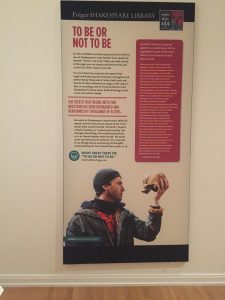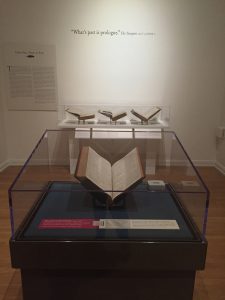First Folio! The Book that Gave us Shakespeare
Location: nationwide
January 6 2016-January 8 2017
First Folio! The Book that Gave us Shakespeare is a small traveling exhibition that is making its way around the United States as a part of the global celebration of the 400th anniversary of Shakespeare’s death. The exhibition was created by the Folger Shakespeare Library in Washington, D.C., and will conclude Nashville on 8 January. This review is of the showing at the Michael Carlos Museum at Emory University in Atlanta, Georgia. The exhibition was free to visit, and was housed in a small room off the main gallery spaces. The Carlos Museum’s staff were incredibly friendly and welcoming, guiding me to the space and making themselves available to answer any questions.
The exhibition consists of five panels and two cases: One case housing the first folio, and the other housing the second through fourth folios, each open to a different section that highlights a different aspect of the text. The first folio was open to Hamlet’s famous “To be or not to be” speech, and the teacher in me was pleased to see that the label copy pointed to the location of the text within a copy where those familiar lines would have been read by someone who had been alive during the time of Shakespeare. This is one of many examples of the exhibition’s central premise, urging visitors to not only think about Shakespeare as a historical writer but also as the writer of plays that are still alive with us today.
The panels offer a very broad overview of the publishing history of the folios, and articulate their value to the modern world by showing what plays would have been lost without this compilation. The panels try to appeal to a general audience by highlighting the continued importance of Shakespeare’s work, largely through showing popular examples of modern renditions (both reinterpretations and faithful recreations). There is a sixth panel, which includes the logos of the exhibition sponsors, but with limited space in the exhibit I felt this space could be better used if shared with some additional text.
In addition to the folio exhibition, host organizations coordinate programming and ancillary exhibitions to highlight different aspects of Shakespeare’s legacy that are beyond the scope of the exhibition itself. For example, in Emory’s Rose library, adjacent to the Carlos Museum where the exhibition is housed, there is an exhibition of modern artists’ books that respond to or convey Shakespeare’s writing curated by Kate Doubler. This builds upon the exhibition’s central premise that Shakespeare’s work is timeless by offering examples of how artists still engage with it today. In addition to complementary exhibitions, host organizations offer an array of programming that speaks to specialist and generalist audiences.
I would recommend the exhibition for general audiences, including students, particularly those with limited exposure to Shakespeare. During my time in the exhibition, I read the panels alongside a couple who had never seen the folios and who were eager to know more about an author whose name they knew but whose legacy they were only vaguely familiar with. It was refreshing to attend the exhibition as a scholar and vicariously experience the joy that comes with experiencing the power of rare books for the first time.
Dr. Julia Skinner
Rare Books Curator, Kennesaw State University



